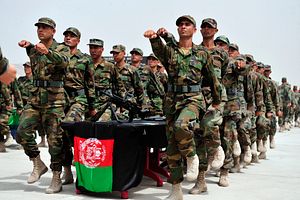On Thursday, three American doctors were killed by an Afghan security official in what was meant to be a safeguarded Christian hospital in Kabul. A few weeks ago, Pulitzer Prize-winning photojournalist Anja Niedringhaus was shot and killed by an Afghan policeman while she was reporting on the Afghan elections. Last year, several U.S. and NATO troops were killed by Afghan soldiers in what came to be known as “green-on-blue” attacks. These attacks represent an insidious threat in Afghanistan and one that demands urgent attention by the government, the police forces, and the Afghan National Security Forces (ANSF).
The responsibility for these attacks rests with the attackers in most cases, but that does not mean that Afghanistan’s security institutions should not attempt to do a better job at vetting those they include among their ranks. If Afghanistan’s friends and allies cannot feel secure with the protection provided by national police or the ANSF, that will be a significant setback to the future of foreign interaction and assistance within the country.
Isolating these “rogue” policemen and soldiers is seemingly an intractable problem. Often these attacks come after slowly pent up resentment and anger reaches a tipping point. Afghan officials, admittedly, can do little to vet the thousands of men and women serving in the nation’s broad security apparatus, which is growing every day to combat the much larger threat of the Taliban insurgency. Recommending that the Afghan government pursue in-depth personality or psychological screening would ignore the resource constraints of the ANSF, ANA, and the national police.
However, the Afghan government must devote serious attention to preventing these sorts of attacks in the future, lest they permanently taint the perceptions of journalists, aid and NGO workers, and troops working in the country. These men and women should be able to carry out their work fully trusting the police and security forces of Afghanistan.
Possible steps that could mitigate these sorts of attacks would be to allow for troops to report any perceived threats to an oversight group or their superiors. While most of the recent attacks do seem to be a case of one lone individual acting, the above suggestion could slightly mitigate the risk of the green-on-blue attacks, which have been known to occur with the cooperation of several perpetrators.
As far as some other attacks go, they are often prompted not by any ideological, religious, or partisan motivation (including affiliation to the Taliban), but simply as an act of vengeance for collateral damage or, in some cases, cultural insensitivity by foreigners.
As Afghanistan gears up for a general withdrawal of U.S. and NATO troops at the end of the year and takes its security into its own hands, it will face a host of challenges. With the relative security of the recent elections, the ANSF, ANA, and Afghan police have shown that they can be a remarkably efficient and professional force for security in the country. Losing the trust of those they protect would significantly hamper the ability of these institutions to perform their intended role in Afghan society.

































